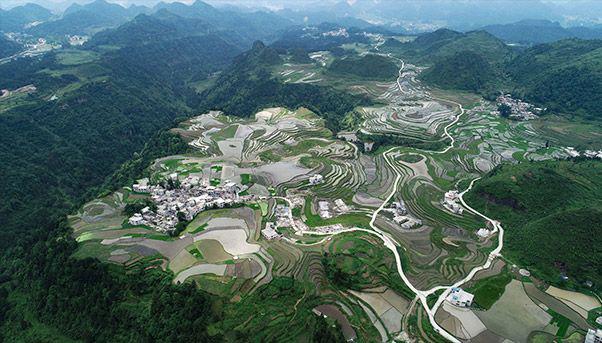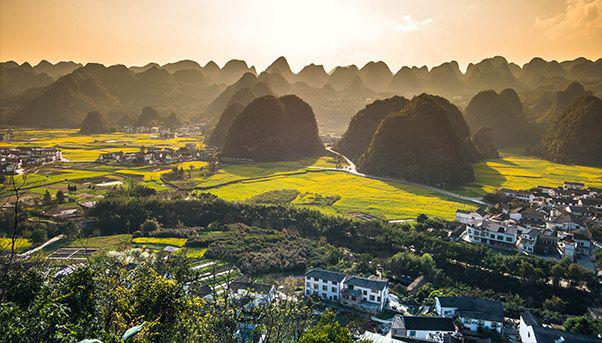
Once upon a time, Guizhou was one of China’s poorest provinces. Then along came high-speed trains, highways, suspension bridges, and concrete buildings. Now the farmers who used to eke out a living on the mountainsides have abandoned the fields and joined the construction industry, moving from their ancestral villages into new residential complexes built in record time.
Guizhou is an isolated, mountainous region known for rural villages in China’s southeast, not too far from the Chongqing and Nanning megalopolises. From 2012 to 2017, the Chinese government poured infrastructure investments into the area, increasing the amount by 20% each year and transforming the habits of millions of people. The landscape is now dotted with major construction sites and new residential areas like the Evergrande Happiness Number 33 Village, where hundreds of farmers moved two years ago. The housing complex is symbol of social mobility for the local population, and a starting point for a new life working on the building sites of area’s massive infrastructure projects.
Guizhou’s infrastructure boom
Guizhou’s infrastructure boom took place because the province is along the “One belt, One road” route, the new Silk Road that will connect China with Europe through an integrated transport system. For Beijing, transforming the agricultural region into a modern transport hub has been a strategic imperative.
«Guizhou became an important passage between China and the world more than 2,000 years ago», said China’s Foreign Minister Wang Yi.
And so between 2012 and 2017 the Chinese government invested over $100 billion in infrastructure projects in the region, three times the cumulative investments made between 1978 and 2012, according to data from Guizhou published by CNN. These funds launched 69 highway projects for a total of 3,542 miles (5,700 kilometres), which will reach 6,241 miles (10,000 kilometers) by 2022, connecting more than 80% of the villages to each other.
The investments involved all types of infrastructure, not just highways. Eleven airports were built between 2014 and 2017, and six more will be completed by the end of next year; 35 waterways have been made navigable. The greatest effort has been made in terms of high-speed rail. The government plans to build 1,087 miles (1,749 kilometres) of high-speed railways in the next five years to connect Guiyang, the capital of Guizhou, in a time varying from 2 to 8 hours with the megalopolises of the neighboring provinces, and also with the Pearl River delta and the Yangtze River delta.
The world bridge museum
The region’s geography of valleys, rivers and mountains has made it become the “the world museum of bridges.” Forty of the 100 highest bridges in the world are located in Guizhou. In December 2016, the Beipanjiang Bridge became the highest in the world, soaring1,854 feet (565 metres) above from the river below. Other record-breaking bridges such as the Yachihe Bridge or the Henzhang Bridge have attracted worldwide attention due to the incredible transformation experienced by this region.

The economy driven by infrastructure
Like elsewhere all across China, infrastructure spending in Guizhou has been the motor for economic growth and social mobility. Chinese government figures indicate that 6.7 million people have emerged from poverty in the last five years thanks to the development of the area, the highest number of any Chinese province. Thanks to infrastructure investments, the region’s trade balance reached $8.7 billion in 2017. Becoming a transport hub means becoming a logistics center for trade, but also an attractive hub for foreign investors.
The growth created by the infrastructure investments should spread to other economic sectors in the coming years, starting with the manufacturing industry. The government’s forecasts indicate the region’s GDP will grow 10% each year until 2022, when it will reach $317 billion. This goal was unthinkable only a few years ago. However, it seems to depend on how much the government will continue to invest in infrastructure.
The fall in investments slows down the economy
After years of incessant growth, the Chinese economy is slowing down. This is visible in Guizhou, considered by many to be the symbol of the Chinese miracle.
Official government figures indicate that infrastructure investments increased by 12% between June 2018 and June 2019, down from a 17% growth the previous year. This slowdown affects the whole country, and is more significant in some areas than others.
According to the Financial Times citing Chinese government figures, last year national infrastructure investments increased by just 2.8% from the previous year, compared to a growth of 17% recorded in the same period two years earlier. This decline in infrastructure investment is the main cause of the slowdown in the Chinese economy. In this year’s second quarter, GDP grew by 6.2% year on year, the lowest figure in the last 30 years.
This slower growth is a wake-up call for China’s future ambitions. Nowhere is this call heard more clearly than in Guizhou, where its new bridges, railways and highways await an economy able to sustain the growth momentum envisioned by this massive infrastructure investment.

